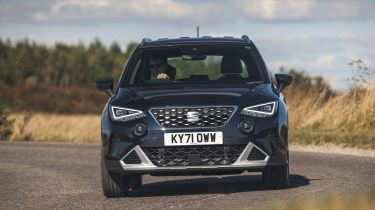SEAT Arona SUV - Engines, drive & performance
The SEAT Arona offers decent agility and strong performance, but falls short of delivering fun
Unlike some small SUVs, the Arona doesn't offer four-wheel drive, nor any kind of off-road traction-control system. If you’re looking for a family car that'll take you off the beaten track, the Citroen C3 Aircross or Peugeot 2008 will suit you better thanks to their ‘Grip Control’ system, while the Dacia Duster or Jeep Renegade can offer proper four-wheel drive and real off-road ability.
Tarmac is the Arona’s home territory, and here it acquits itself well. The steering is precise and nicely weighted, and while there’s not a lot of feedback, you quickly learn how much lock is required when cornering. The Arona can be driven through fast turns with some vigour, eventually running wide if you overstep the mark.
That takes some doing, though, and your passengers will become anxious long before you reach the Arona’s roadholding limits. Even in spirited driving, the body feels neatly controlled and resists leaning into corners. It behaves very much like a taller, heavier SEAT Ibiza – essentially what the Arona is. It’s sharper and more fun than the Suzuki Vitara or MG ZS, and while it’s firmer than the Citroen C3 Aircross, it still rides bumps in a controlled manner. This makes it one of the best small SUVs to drive, without quite beating the poise of the Ford Puma.
SEAT Arona petrol engines
The range opens with a 94bhp, three-cylinder 1.0-litre TSI that comes with a five-speed gearbox. A 109bhp version comes next, with a six-speed manual and the option of a seven-speed DSG automatic transmission. The latter pulls strongly at all speeds, accelerating strongly from rest to reach 62mph in 10.6 seconds – 10.8 for the DSG version– and makes effortless progress when joining fast-moving motorway traffic. There’s little of the delayed response that turbocharged engines often suffer from, either. The DSG automatic is one of the best in its class, with smooth and snappy changes, although it can be a little jerky while parking.
Once up to motorway speed and in top gear, the engine becomes fairly subdued, but still has the tonal character of a three-cylinder engine, with a distinctive and noticeable thrum. The noise inside the car is actually from the wind rushing past the mirrors, rather than from the engine, and it’s more refined than a C3 Aircross. The only real way the engine registers with the driver is through mild vibration in the accelerator pedal.
The 1.5-litre four-cylinder engine is reserved for FR and FR Sport models, where its 148bhp gels with these models’ sporty looks. It is, of course, noticeably more powerful than the 1.0-litre, but feels solidly powerful rather than breathtakingly fast. It certainly makes life more relaxing, though, with more power available instantly no matter which gear you're in.
Diesel engines
Both the 94bhp and more powerful 113bhp diesel engines have been discontinued. Refinement took a slight knock with the diesel fitted, but diesel Aronas still drive with little body lean and smooth gearshifts. It has a decent amount of pulling power, providing the Arona with enough pace for overtaking slower traffic.
Which Is Best?
Cheapest
- Name1.0 TSI S 5dr
- Gearbox typeManual
- RRP£20,395
Most Economical
- Name1.0 TSI S 5dr
- Gearbox typeManual
- RRP£20,395
Fastest
- Name1.5 TSI 150 FR 5dr DSG
- Gearbox typeSemi-auto
- RRP£28,185










